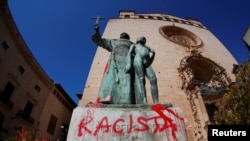California protesters this week toppled several statues of Spanish priest Junipero Serra, spurred by the anti-racist movement sparked by the death of an African American man last month while in police custody in Minneapolis.
Discussions about police brutality have ignited debate over historical symbols of colonialization, slavery and cultural genocide, such as statues of Confederate war heroes and Christopher Columbus.
On June 19, protesters toppled a statue of Serra in San Francisco; a day later, during demonstrations in Los Angeles, protesters brought down a second Serra statue that stood near Union Station.
Happy to see the Junípero Serra statue taken down. He was part of the colonial system when my town rose up against the Spanish in 1755. He was a fundamentalist and played a key role in the subjugation of Indigenous people, from Queretaro to the Bay. He deserves no monument.
— Chema Hernández Gil (@elsanfranciscan) June 20, 2020
Serra was an 18th century Spanish missionary who established 21 Catholic missions in California as part of efforts to Christianize and assimilate Native Americans into European culture.
These missions pushed Native Americans into harsh labor and poor living conditions that left them vulnerable to disease and famine, often costing them their lives.
“So many Native Americans were abused and killed in order to get these missions built,” said Rick Cuevas, a disenrolled member of the Pechanga Band of Luiseno Mission Indians.
Serra and the missions he established had previously been a subject in the California education system.
“The sad thing is that part of the California educational system, up until a year or two ago, one of the fourth-grade projects was to have them build missions,” Cuevas said. “But there was never any discussion about how those missions were built and what labor it took undertaking those tasks.”
today i learned it wasn't just a thing at my school: everybody from california had to build a model of a mission in 4th grade
— Megan Adams (@mnmnadams) June 23, 2020
In 2015, Pope Francis sparked controversy when he canonized Serra as a Roman Catholic saint.
In an open letter to Pope Francis, the Pechanga Band denounced the canonization of Serra.
Serra’s mission system “triggered a collapse of our indigenous societal structure and way of life and set into motion the atrocities and hardships that our people endured for nearly two centuries,” the letter said.
While many Native Americans view the dismantling of Serra statues as progress toward dismantling the legacy of racism in the U.S., some Native Americans believe there are better ways to encourage change.
“The proper way is to learn and teach rather than put a rope around the side [of the statue],” Cuevas said.
Several California pastors have removed statues of Serra in order to protect them from vandalism.
“The Church cannot support such violence imposed on any group, nor can it support the violent destruction of sacred symbols of any faith community,” Bishop Daniel E. Garcia wrote in a letter to the Monterey Diocese he oversees. “After exhaustive investigation it is clear St. Serra made heroic sacrifices to protect the indigenous people of California from their Spanish conquerors and soldiers.”
The Embassy of Spain USA this week defended Serra on Twitter.
(1/4) We deeply regret the destruction of the statue of Saint Junípero Serra in San Francisco today, and would like to offer a reminder of his great efforts in support of indigenous communities.
— Embassy of Spain USA (@SpainInTheUSA) June 20, 2020
Thread ⬇️ pic.twitter.com/qJOmsjorjS






